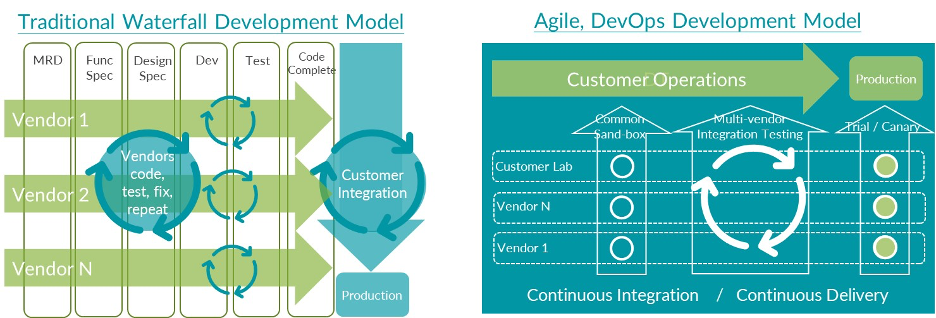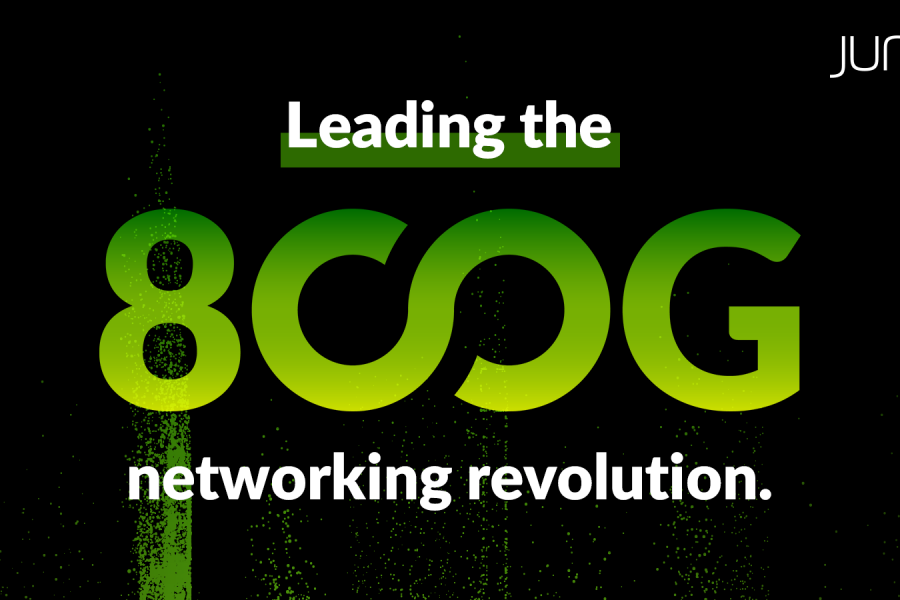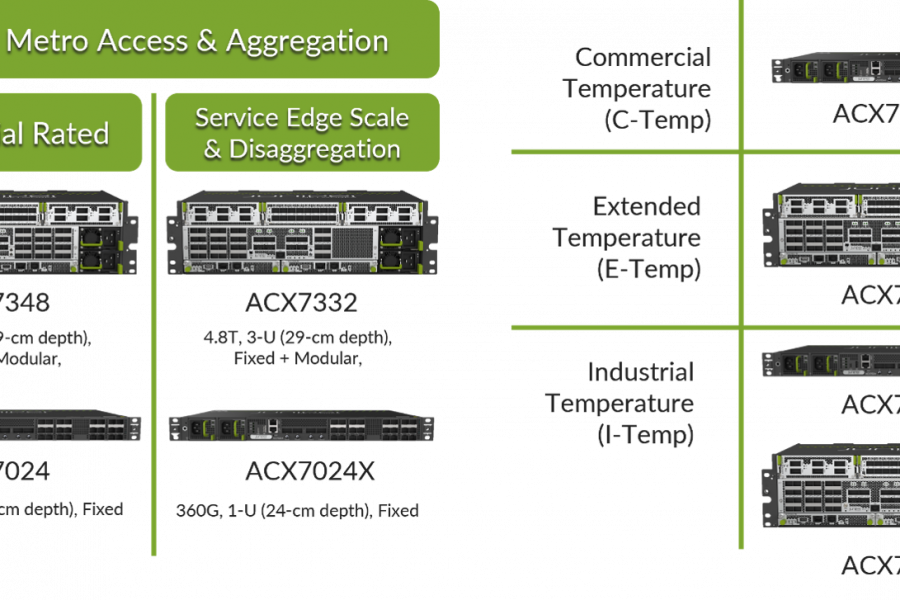Deutsche Telekom (DT), a Juniper Networks customer, recently announced the successful achievement of a major milestone in the deployment of their next generation voice service. A critical public service and important part of DT’s service portfolio, the IP Multimedia Subsystem (IMS) delivers fixed voice services to over 20 million residential and business subscribers in Germany. The virtualization of IMS is nothing new as many operators have successfully migrated IMS to a cloud platform. Unlike the rest, DT uniquely collaborated with a team of vendor partners to implement the necessary skills, automation and cloud technologies to modernize their Next Generation IMS (NIMS) voice delivery platform in less than half the time of other comparable projects. While most operators understand the need to invest in people, processes and technology to achieve transformation, how is it that few operators have achieved DT’s level of success, regardless of the time scale?
Part of the answer lies in an operator’s perspective and relationship to their customers. Being at the forefront of many transformational technologies, operators naturally gravitate to the technologies required to deliver innovative services and the development of skills to master those technologies. In addition, many existing operational models and their supporting tools are created internally or highly customized, making changes to these systems time-consuming and arduous.
Successful telco cloud deployments, on the other hand, start with a foundation built upon the processes and automation necessary to operationalize and achieve cloud outcomes, such as agility, flexibility and rapid time to market. Building technology and skills first and then trying to retrofit processes is a bit like grocery shopping without a list – it’s possible but it takes longer, you invest in things you don’t need and it costs more.
At Juniper, we’re working with and helping service providers like DT develop and deploy telco clouds. Through this unique and extensive experience, we have identified three key disciplines shared by our most successful customers, who each started their transformation journey with an operation-first mindset:
- Operation-First Starts with an Automation Framework
- Fast Fail Innovation Builds on Agile Methodologies
- Rapid Deployments Strengthens with CI/CD Based Lifecycle Management
Operation-First Starts with an Automation Framework
Digital transformation and the adoption of telco cloud technologies are as significant to the daily operations of a service provider’s business as was Henry Ford’s introduction of the assembly line to the automobile industry in 1913. Ford’s innovative but low-cost design of the Model-T was relatively easy compared to the challenge of manufacturing the car at scale. Ford first conceptualized the processes and automation – the use of assembly line techniques and deconstruction of the Model-T assembly into 84 discrete steps – before building the assembly infrastructure and training his workers. The approach was logical and the results unquestionably successful, but over 100 years later, most operators reversed the order when building clouds, starting with technology and skills and attempting to retrofit existing processes to accommodate cloud operations.
Technology and skills are certainly important but digital transformation encompasses all aspects of the business, from the way operators interface with customers to the definition, development and delivery of products. Like the Ford assembly line, transformation changes business fundamentals. Today, the operators that began their journey with a documented automation framework and well-defined workflow maps have prevailed. The framework establishes the end-to-end automation processes and tools while acting as a guidepost to select the vendors with the right technology and commitment to support the operator’s vision. Detailed workflows help all employees, from engineers to executives, understand the mechanical changes to each job function as well as the changes for cross-functional collaboration to complete the supply chain. Taking an inside-out approach, some operators have even launched extensive cloud training programs to educate employees on telco cloud fundamentals, processes and technology at levels appropriate for each job function.
Fast Fail Innovation Builds on Agile Methodologies
Unlike the Model-T where each part and subsystem of the car was manufactured by Ford, operators today rely on an entire ecosystem of partner vendors to run the business. While operators have invested into their own software development teams, they continue to rely on partners to deliver specialized products and technologies supporting everything from infrastructure to services. Successful operators have evolved their working relationship with partners, adopting agile, DevOps-based methodologies to foster new levels of collaboration, operating as a cooperative and unified development team. Using agile tools like Scrum and Kanban, operators and vendors work together as a cross functional team using iterative development to deliver value faster, with greater quality and predictability and greater agility to respond to change. In this model, operators shift from being consumers of the vendors’ development to working side by side with vendors in a shared cooperative to deliver working solutions into production.
What was wrong with the previous model? Most operators and vendors use waterfall development models which are effective for well-defined and static projects. However, in a dynamic, cloud-based environment where the delivery of a service is dependent upon the integration of many applications from multiple vendors, waterfall development can be unreliable, resulting in poor quality and costly delays. With waterfall, each vendor develops code within their own horizontal swim lane, serializing the process of requirements definition, software design, coding and system test until code is ready for delivery. Project changes or quality issues require independent iterations within each stream meaning synchronized delivery of code by all vendors is challenging. Once all vendors have delivered their code, the onus falls to the operator who must perform integration and verification tests to productize the service. If one or more of the vendors fails to deliver, the code is kicked back into the vendor’s waterfall to start again.

Agile methodologies turn the horizontal swim lanes of waterfall upside down, creating a set of vertical integration ‘sprints’ that allow operators and vendors to continuously test and integrate compartmentalized blocks of code during development versus after the code is complete. This iterative model establishes daily, multi-vendor collaborations where potentially fluid goals and outcomes can be compared to existing project objectives to make frequent, unified and time saving course corrections. The result is a more dynamic, flexible and collaborative work environment that aligns the operator and vendors to achieve success together.
Rapid Deployment Strengthens with CI/CD based Lifecycle Management
The adoption of Continuous Integration/Continuous Delivery (CI/CD) pipelines is an important tool to operationalize and fortify the automation framework. Operators have discovered the value of establishing CI/CD pipelines to automate the development and testing of code (continuous integration) and automate the deployment and monitoring of that code into production (continuous delivery). CI/CD uses version-controlled software repositories and the use of software branches to test and validate code before it is merged into mainline. Once in mainline, the use of template and site-specific variable files automate the rendering of configurations to be used for fixes, updates and upgrades across the entire operator network. This is especially crucial for operators who are distributing their clouds to potentially 100s or 1000s of locations where automation is the only way to manage a scaled, edge cloud environment. CI/CD allows operators to shift from off-hour and weekend maintenance window software changes to an automated operation where code can be introduced into live production networks on a daily basis.
There are many open source tools like GitLab that provide the foundation to create custom pipelines but be aware that you are not likely to purchase an out of the box CI/CD solution. Every operator environment is different and the number and types of CI/CD pipelines to support those environments requires customization to ensure the level of automation and the pipelines required to support operations. What is important is the development of a standard CI/CD blueprint to create a consistent automation environment across the hardware platforms, NFVI infrastructure and VNFs and CNFs that run on top of the cloud platform. If the knowledge and expertise is not organic to your organization, it is important to work with an experience partner to help define a company-wide CI/CD blueprint and architecture.
Juniper has developed a unique cloud-first approach to telco cloud allowing service providers to transform in the ‘Cloud + 5G + AI’ era. We provide all the key telco cloud technologies and professional services to help our customers implement an operation-first approach to automation built upon agile methodologies and CI/CD pipelines for rapid deployment. By combining our deep networking and software expertise with the use of open source software, standard protocols and open APIs, we’re able to deliver a universal, open and agile cloud architecture that extends to the edge for rapid service innovation and delivery.


